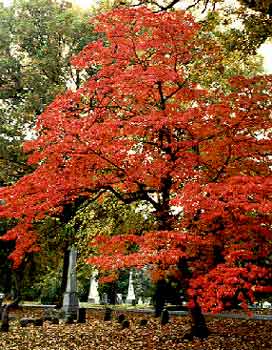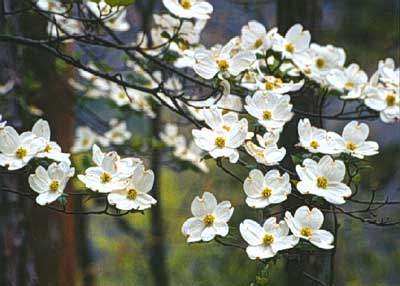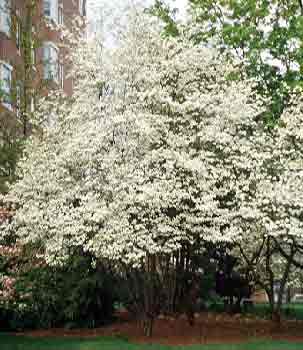 Flowering Dogwood - Cornus florida
Flowering Dogwood - Cornus florida
Dogwood Family (Cornaceae)
Flowering dogwood is recognized by most people for its spring floral display that can be white or pink. The showy part is actually a leaf-like bract under the tiny flowers. It is a common understory tree in wooded areas throughout the state. The Kentucky champion tree is in Warren County and is about 35 feet tall.
- Native habitat: Massachusetts to Florida, west to Texas, Mexico and Ontario.
- Growth habit: Shrub-like or a small tree with low branches. Usually has a flat-topped crown and is wider than high when mature.
- Tree size: 30 to 40 feet with a greater spread.
- Flower and fruit: True flowers are greenish yellow and insignificant; the four bracts are showy. The four together are 3 to 4 inches across. Blossoms are effective for 10 to 14 days in April or early May. Fruit is a glossy red drupe that ripens in September to October. It can persist until mid-December. Birds love it.
- Leaf: Opposite, simple leaves are 3 to 6 inches long and oval. Leaves are bronze-green to yellow-green as they unfold, then turn dark green in summer. Fall color tends to be red to reddish purple.
- Hardiness: Winter hardy to USDA Zone 5.
There are nearly 100 cultivars of flowering dogwood. Selected cultivars by category include:
- Large Flowers:
- ‘Barton' - Good white cultivar for southern gardens.
- ‘Cloud 9' - Reaches a height of only 15 feet with a 20-foot spread. Produces many white flowers at an early age.
- ‘Junior Miss' - Large pink bracts that are resistant to spotting.
- ‘Spring Grove' - Selection from Spring Grove Cemetery in Cincinnati. Heavy producer of flowers and fruit because it sets up to three buds at each shoot tip.
- ‘Spring Time' - Large flowers and good winter bud hardiness.
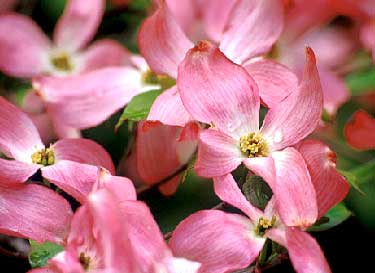 Pink or red flowers:
Pink or red flowers:- C. florida rubra - This tree is an old favorite with pink flowers and red fall foliage.
- ‘Cherokee Chief' - Has rose red to ruby red flowers and red fall color. Reaches a height of 20 feet with a similar spread.
- Cherokee Sunset™ - Deep pink to light red flowers and variegated yellow and green foliage. Leaves turn red in fall.
- ‘Red Beauty' - Red bract color on a compact plant.
- ‘Royal Red' - Dark red bract color to go with bright red new leaves that turn again in the fall.
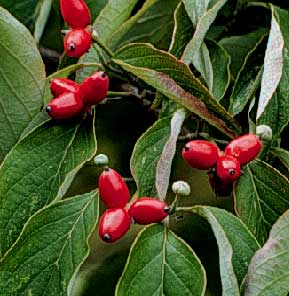 Variegated foliage:
Variegated foliage:- Cherokee Daybreak™ - White flowers and green and white variegated foliage. Resistant to leaf scorch.
- Cherokee Sunset™ - Deep pink to light red flowers and variegated yellow and green foliage. Leaves turn red in fall.
- ‘First Lady' - Leaves variegated yellow and white. Flowers have white bracts.
- ‘Welchii' - This variegation is green and white with hints of pink. Does get leaf scorch in full sun. White bracts.
- Unusual growth habit:
- ‘Compacta' - Slow-growing form.
- ‘Fastigiata' - White-flowering form with upright branches.
- ‘Pendula' - Irregular, weeping habit. Flowers are white.
- ‘Pygmaea' - Slow-growing (dwarf) plants with a rounded habit. If plants bloom, they are white.
- ‘Salicifolia' - Slow-growing plant with a rounded growth habit. The leaves are narrow and "willow-like." Does not flower.
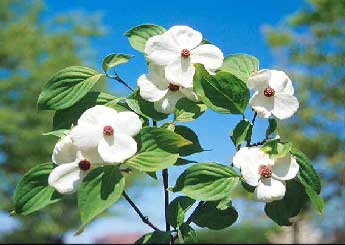 Rutgers Stellar series:
Rutgers Stellar series:
Through the breeding efforts of Dr. Elwin Orton, Rutgers University has introduced hybrids of C. florida and C. kousa, known as Rutgers Stellar series. The hybrids start blooming after Cornus florida finishes and produce no fruit. They are highly resistant to dogwood borer and moderately to highly resistant to dogwood anthracnose. They reach an average height of 20 to 30 feet with a 15- to 25-foot spread. The hybrids are more vigorous than the parent trees with characteristics that are intermediate between the parents. The white bracts are rounded and the flower buds are not entirely enclosed by bud scales when dormant.- Aurora Dogwood (Cornus x ‘Rutban' ) - This tree is erect with a uniform width. Its white flowers, which have a velvety look, become creamy white with age. The tree starts flowering 2 to 3 days after flowering dogwood has quit.
- Constellation Dogwood (Cornus x ‘Rutcan') - A low-branching tree with uniform width, and white bracts with acute tips. It starts flowering about the same time flowering dogwood quits flowering.
- Celestial Dogwood (Cornus x ‘Rutdan') - The white bracts overlap and have a green tinge, although they become pure white after a few days. This tree starts flowering 2 to 3 days after C. florida has stopped flowering.
- Stardust Dogwood (Cornus x ‘Rutfan') - This low, spreading tree is smaller than the other Rutgers hybrids. This tree has heavy branching to the ground, like a hedge. Its white bracts do not overlap and have acute tips. It begins to flower at the same time flowering dogwood's flowering period is ending.
- Stellar Pink Dogwood (Cornus x ‘Rutgan' ) - This low-branching tree has rounded, soft pink bracts. This tree blooms one week after flowering dogwood.
- Ruth Ellen Dogwood (Cornus x ‘Rutlan') - This tree has white flowers and a low, spreading habit like flowering dogwood. It is the first of the Stellar series to bloom, overlapping the last days of flowering dogwood.
The showy part of the dogwood flower is not the flower at all but the bracts! The true flower is greenish yellow and insignificant. The bracts are white and about 2 inches long, and are effective for 10 days to two weeks in April or early May. Flower buds are flat and biscuit-shaped.
Borers are a big threat to flowering dogwood, especially when its trunk is damaged by lawn mowers. It is best to locate dogwood in a bed to Cornus florida protect it from lawn mower damage.
Symptoms of anthracnose include large tan blotches or purple-rimmed leaf spots. Infected leaves tend to remain on the tree after they normally would have fallen. Trees often die within two or three years after onset of the disease.
The wood of dogwood has a high resistance to sudden shock, making it a popular choice for making golf club heads and chisel handles. It is also used for mallet heads and wedges, as it can be hammered on the ends without splitting and mushrooming out. It was once used to make hay forks, hubs of small wheels, rake teeth and machinery bearings because it wears smoother as it is used. Ninety percent of dogwood cut since the late 19th century has been used to make shuttles for the textile industry. With a mechanical loom, the shuttle is hurled at top speed, and a wood has to be used that wears smoother and will not crack under the strain. Dogwood is ideal.
The inner bark of the flowering dogwood root contains the alkaloid cornin. Native Americans used it as a treatment for malaria. They also used the onset of flowering to time the planting of their crops.Pioneers would steep dogwood bark in whiskey, then drink this to treat "the shakes." Some native Americans used dogwood bark to derive a scarlet dye, which they used to color bald eagle feathers and porcupine quills. Dogwood tea, made from the tree's bark, was used as a substitute for quinine during the Civil War. Tea made from dogwood bark was used to induce sweating to break a fever.
In modern times, overuse of flowering dogwood as a cut flower has threatened native stands of the tree. In the Washington, D.C. area, the Wild Flower Preservation Society placed posters on city streetcars, urging people not to cut or buy dogwood sprays. Sales dropped to such an extent that many merchants stopped marketing it.
Legend has it that dogwood was once a tall tree, but that changed when it was chosen to make the cross where Jesus Christ was crucified. The legend says the tree was ashamed, and asked Christ to forgive it. Christ commanded that from that moment on, the dogwood would be slender and twisted so that it could no longer be used for a cross. The tree was designated to bear flowers that were cross-shaped, with a crown of thorns in the middle, and nail prints stained with red at the outer edge of each petal. Of course, flowering dogwood is not native to the area where Christ was crucified.


